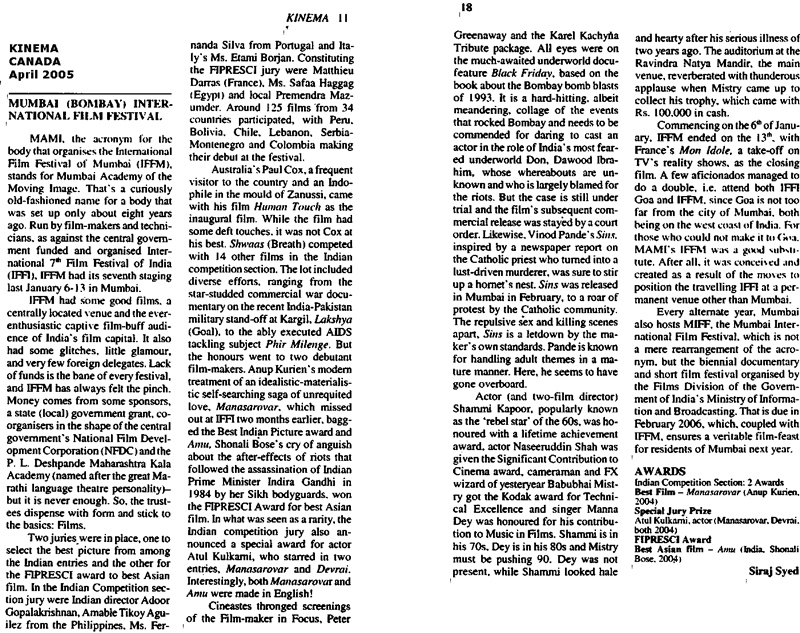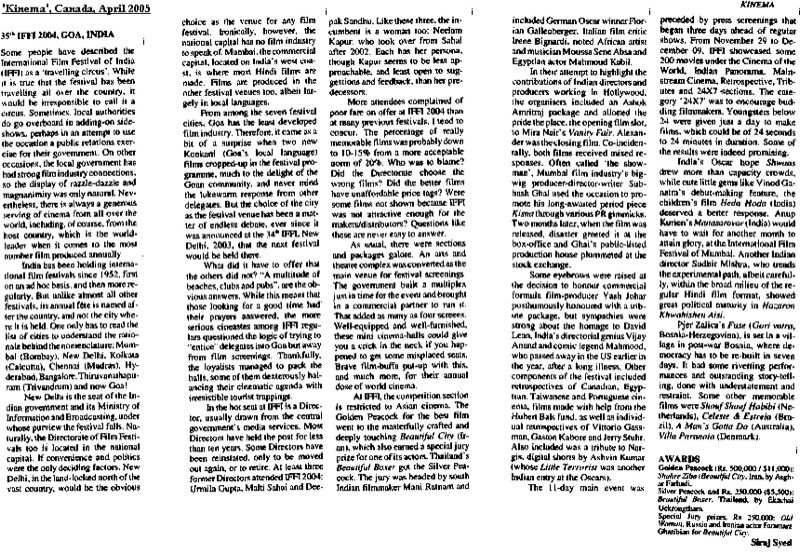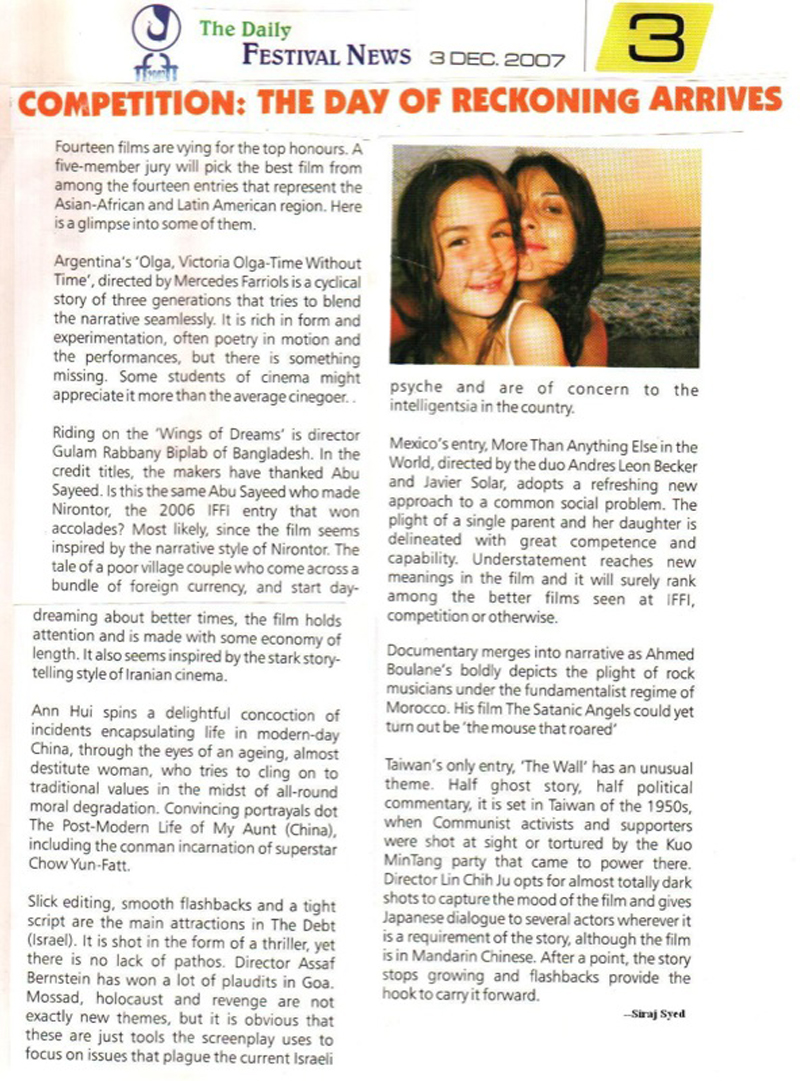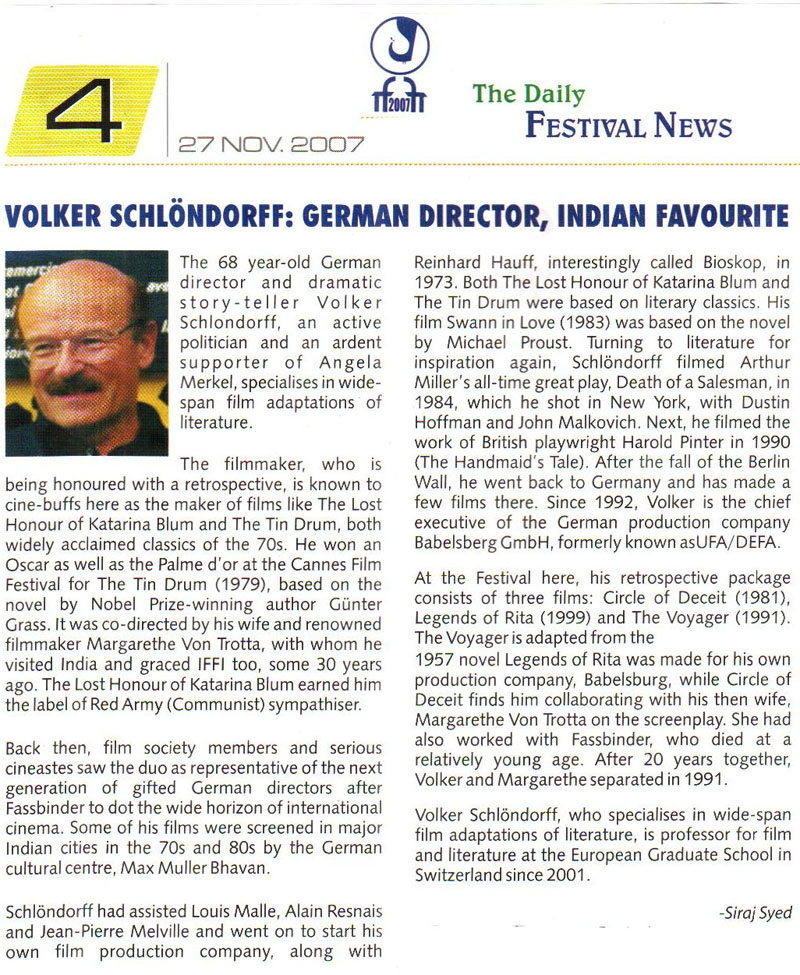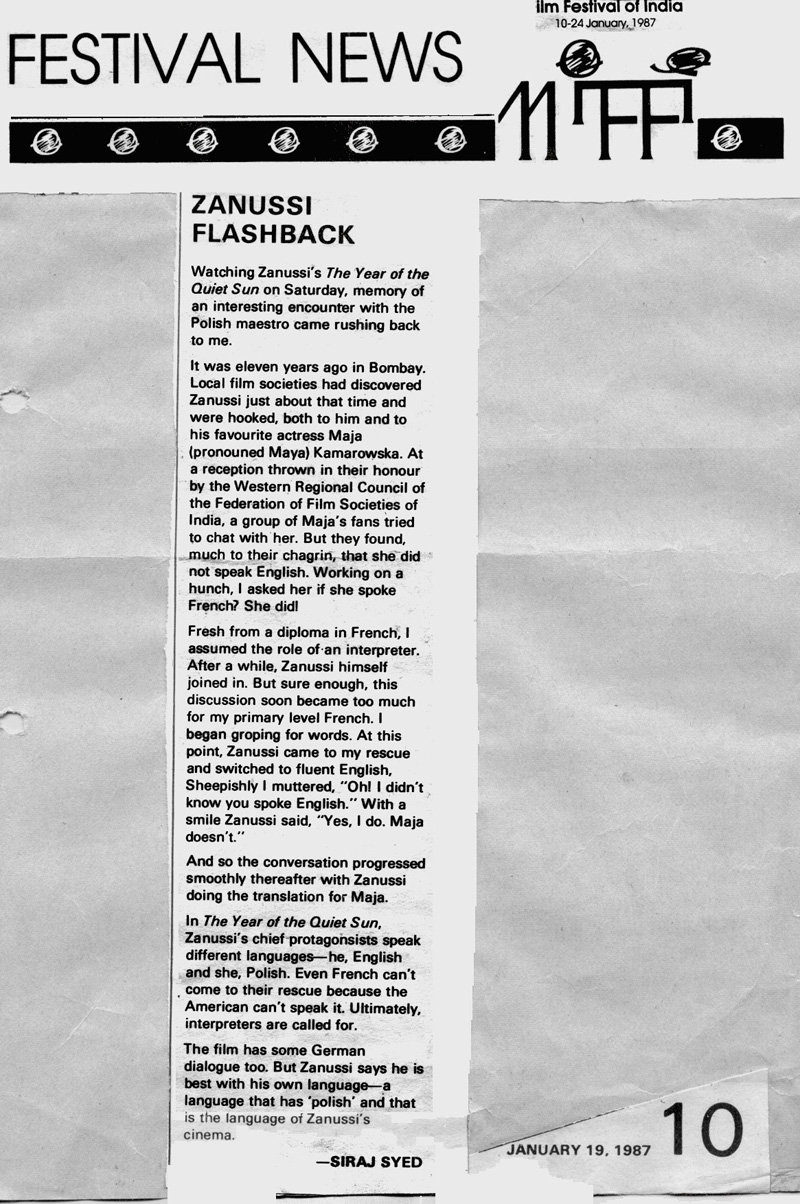|
|
||
|
Pro Tools
FILMFESTIVALS | 24/7 world wide coverageWelcome ! Enjoy the best of both worlds: Film & Festival News, exploring the best of the film festivals community. Launched in 1995, relentlessly connecting films to festivals, documenting and promoting festivals worldwide. Sorry for the interruption, we needed to correct and upgrade some modules. Working on a new website. For collaboration, editorial contributions, or publicity, please send us an email here. You need for put your full detail information if you want to be considered seriously. Thanks for understanding. User login |
Siraj SyedSiraj Syed is the India Correspondent for FilmFestivals.com and a member of FIPRESCI, the International Federation of Film Critics. He is a Film Festival Correspondent since 1976, Film-critic since 1969 and a Feature-writer since 1970. He is also an acting and dialogue coach. @SirajHSyed  Gangubai Kathiawadi, Review: Guess what is the oldest profession in the world, and meet its President
Gangubai Kathiawadi, Review: Guess what is the oldest profession in the world, and meet its President Gangubai, a variation of Ganga, is the most common name of Maharashtrian maid-servants in Mumbai. Ganga becoming Gangu is quite normal, while the Bai here refers to her designation as maid. An engaging film was made in 2013, with the maid as the central character, only it was spelt phonetically more correct, Gangoobai. In other parts of the country, Bai could mean a courtesan, a classical singer, or a rich lady, depending on where you are. Therefore, Gangubai Kathiawadi strikes you as a strange name, for Kathiawad is in Gujarat, not Mumbai. So, the title, in effect, means Ganga of Kathiawad. There has been enough hype generated about this film for us to be aware that it is not the story of any maid-servant but of a prostitute, who, these days, we address as a commercial sex worker. Hard-hitting, with a few holds barred, in deference to the censors, I presume, the flatters to deceive, promising a whole lot and delivering a whole lot less. A little poor girl is sold into prostitution in the red-light area of Kamathipura in Bombay, in the early 1950s, and is beaten mercilessly in order to make her get on to the job. When she refuses to give in, her Madam calls in Gangubai, to help set her right. Instead of persuading her to get into the trade, Gangubai asks for her release, for she discovers that the girl is bent on dying rather than turning to prostitution. She even pays the Madam ten times the price she had paid to buy the young girl, and takes her away. And then she narrates her own story. Ganga, the daughter of a barrister, is conned into believing that her lover Ramnik is taking her to Mumbai to meet her idol Dev Anand and to get her to work in films opposite him. He arrives with train tickets, interrupting her zestful garba dance, and asks her to carry with her the family’s gold and jewellery, promising to return them soon. At Bombay, he sells her off to a Madam and disappears. She puts up stiff resistance, but there is no other option but to give in. But our heroine, Ganga, is different. She decides to usurp power from her Madam and work her way to becoming a Madam herself. One day, the Madam sends her a customer who is known to be violent towards his partner, in an attempt to quell her ambitions. He beats the hell out of her and makes a deep gash on her stomach. Madam does not help. In fact, she keeps the door locked from the outside, while it is latched from the inside. To her good luck, she learns that the man works for Lala, an underworld Don, who is known for dispensing his own form of justice. Gangu manages to trace the Don and get an audience with him. He is outraged, and decides to teach his employee a lesson. When informed by his watch-dog that the man is visiting Gangu’s kotha (den) again, he rushes to the spot, pulls the man out and smashes his head on his car’s bonnet several times. Lala and Ganga develop a bond, and he begins to treat her as a sister. This leads to the meteoric rise of Gangubai, who becomes the second most powerful woman in Kamathipura. The first is a eunuch, called Razia. Her eyes are now set on dislodging Razia and acquiring the post of President of the prostitutes of Kamathipura. In the credit titles, we read that the story is based on one chapter in the book, Mafia Queens of Mumbai by S. Hussain Zaidi (Indian author and former investigative journalist; works include Dongri to Dubai: Six Decades of the Mumbai Mafia, Black Friday, My Name is Abu Salem, and Mumbai Avengers) and Jane Borges (Indian; assistant editor at the Mumbai tabloid, Mid-Day). Knowledgeable sources say that it is loosely inspired by the real-life story of Ganga Harjivandas. What these two authors have written goes through the grind of Sanjay Leela Bhansali, who also directs, edits and composes the music, Utkarshini Vashishtha and Prakash Kapadia. So, it is five pen-pushers that have contributed to the narrative. It begins on a good note, but we are soon given to scepticism when we see a barrister’s educated teenage daughter eloping with the family jewels to Mumbai, defrauded by her lover and possible groom. As the track moves into flash-forward mode, we wonder what was the magic formula that Gangu was going to bring with her that would change the mind of the adamant young girl who refused to sell her body? No hint is given. From manipulative rise to turf war, the tale traces the vicissitudes of Gangu’s life. But this life is full of co-incidences and exaggeration. Calling her a Mafia Queen or Mafia Don, when her activities are confined to running a brothel and serving the clients liquor, seems an undue elevation. Almost all major scenes lead to clap-trap situations, where, the dialogue fails to cash-in. Encounters with Razia are always one-sided, with one party doing the bragging, boasting and humiliating each time. The strategy she uses to keep prospective voters away from a Razia meeting is clever, no doubt. Yet, it is far from convincing, what with there being only 100-odd empty chairs laid out, for an electorate of 4,000+. In twelve years, Ganga never tries to contact her family, and when she does make a phone call, the only thing that impacts you is the blasting she gives to the operator for restricting the trunk-call to the mandatory three minutes. Somebody forgot to tell her that instead of losing her head, she could just call again. Gangu falling in love with a Muslim tailor is nicely written, perhaps the only really moving aspect of the movie. By contrast, her association with a journalist needed far better writing. A woman who bribed the entire police force in her area could have bought over, or at least tried to buy over, the media too, to prevent the impending demolition of Kamathipura, at the behest of a neighbourhood Catholic- run girls’ school, in tandem with the builders’ mafia. Instead, she relies on one reporter from an Urdu newspaper, who she co-incidentally meets, to present her case. A master of period ambience, Sanjay Leela Bhansali recreates the Kamathipura of the late 1940s to the mid-1950s to near perfection. Whether it is a set, or real footage or VFX, they all blend in to give the just the right picture of an era that existed 70-75 years ago. Cinemas of that area, like Alfred and New Roshan, stare right into your face. Posters have Nargis and Suraiya, the stars of that period. The references to early Dev Anand films and the crush Gangu nurtures on him is well brought-out. Ghazals by Begum Akhtar and, possible, Shobha Gurtu, add the audio component of this period piece. It touches your heart when Gangu, in a moment of rare carnal desire, turns the framed picture of Dev Anand around, although it is not the first time this ploy has been used in cinema. Bhansali uses a lot of sign language, probably a hark-back to his debut film Khamoshi, wherein there were deaf-mute characters. Use of props is prominent, like vintage cars, horse-carts, huqqa, cigarettes, a key chain and a pack of cards. Of these, the pack of cards is most prominently used, but fails to have much impact. Given the theme, the film could have oozed sex and nudity, but all Bhansali employs are a few expletives. That might partly explain the granting of a UA Certificate to the film by the Indian censors, advising parental guidance, but not restricting entry to adults only. UA for this theme? Really? Can anything be more adult? Though other actors have contributed, Gangubai Kathiawadi shall remain an Alia Bhatt vehicle. It was difficult to imagine her as a brothel Madam before seeing the film. After the viewing, credit must be given where it is due. Granted that Sanjay’s fondness for his heroine shows in the wide range of emotions and situations he puts her in. Every time she attacks somebody, there is no retaliation whatsoever. Aiding her performance is her voice quality, which is well-adjusted to the character she is portraying. If you see the film for Alia, alone, I won’t blame you. Talented beyond doubt, Vijay Raaz graduates from being a voice-over for quite some time to playing the part of Razia, the reigning queen of Kamathipura. He needs these kind of challenges and not the perfunctory voice-overs in the opening scenes of many a film, to prove his worth. Shantanu Maheshwari as Ganga’s lover Afshaan looks as if he is in a daze, and that is exactly his state of mind. But their love is doomed from the very beginning, a thing that she realises, he doesn’t. Some of the best scenes are written for the couple, as they romance each other, Afshaan oblivious about her standing in society and he about his own humble background. Chhaya Kadam is an absolute natural as the first Madam, while the second Madam, Seema Pahwa, demonstrates how much she can deliver, given a good role. For star value, we have Ajay Devgn in a long cameo, playing Lala. He is his usual, no-nonsense, emphatic, volcanic self. Huma Qureshi appears as Dilruba, in a Qavvaalee, towards the end, and is wasted. Jim Sarbh is chosen to play the reporter from Urdu Times, a substantial part. Sadly, the actor, who was seen in films like A Death in the Gunj, Jonaki and Sanju, is hopelessly mis-cast, and leaves much to be desired. As Kamli, one of the prostitutes and Gangu’s confidante, Indira Tiwari looks like a cross between Chhaya Kadam and Renuka Shahane. As Afshaan’s father, the senior tailor, Baldev Trehan does a decent job. Other acting credits could not be confirmed when this review was posted. Cinematographer Sudeep Chatterjee does full justice to the job at hand, whether it is the white sarees on parade scene or the brownish tones of the skins of the girls in the brothels, the colourful restaurant which is the pick-up joint, or the garba in full throttle. Alia does stand out as the only one with a fair complexion. As editor, several of Bhansali’s cuts are quite surprising. One scene in particular leaves you wondering what happened. Ganga is dancing her heart out on the streets, and then she begins to lose balance, appearing to be ill. Next, she just walks away and we have a fade-out. That’s it. Music is by Sanchit Balhara and Ankit Balhara, while the songs, written by A.M. Turaaz and Kumaar, are composed by Sanjay Leela Bhansali. One Kumaar song has been co-written by two others. At least one of them is an ode to Ahmed Faraaz’s famous nazm, “Suna hae”. Considering the film is a period piece, one must not forget the Costume designer and the Art Director. Both have had a task at hand and have delivered the goods: Art Direction by Pallab Chanda, Costume Design by Sheetal Sharma. Costume dramas or period pieces tend to be long, and this one is no exception. Including the six songs, the duration is mentioned in three different places as 146 minutes, 150 minutes and 154 minutes. I believe the version we saw was 146 minutes, the shortest, and that began to drag too! 120 would be more like it. A director who is considered among the country’s best, Sanjay Leela Bhansali, should not count Gangubai Kathiawadi as another feather in his cap. Telling the tale about the oldest profession in the world required a more professional approach. Both the screen-writing and the story-telling needed to be at least two notches up to have lasting impact. Try it out for yourself. Rating: ** ½ Trailer: https://youtu.be/N1ZwRv3vJJY 25.02.2022 | Siraj Syed's blog Cat. : A.M. Turaz Ajay Devgn Alfred Alia Bhatt Ankit Balhara Baldev Trehan Begum Akhtar bombay Chhaya Kadam Dev Anand Ganga Harjivandas garba Gujarat Huma Qureshi Indira Tiwari Jane Borges Jim Sarbh Kamathipura Kathiawad Kumaar Mafia Don Mafia Queen Maharashtra mumbai Nargis New Roshan Pallab Chanda Prakash Kapadia S. Hussain Zaidi Sanchit Balhara Sanjay Leela Bhansali Seema Pahwa Shantanu Maheshwari SheetaSharma Shobha Gurtu Sudeep Chatterjee Suraiya Utkarshini Vashishtha Vijay Raaz Independent FILM
|
LinksThe Bulletin Board > The Bulletin Board Blog Following News Interview with EFM (Berlin) Director
Interview with IFTA Chairman (AFM)
Interview with Cannes Marche du Film Director
Filmfestivals.com dailies live coverage from > Live from India
Useful links for the indies: > Big files transfer
+ SUBSCRIBE to the weekly Newsletter DealsUser imagesAbout Siraj Syed Syed Siraj Syed Siraj (Siraj Associates) Siraj Syed is a film-critic since 1970 and a Former President of the Freelance Film Journalists' Combine of India.He is the India Correspondent of FilmFestivals.com and a member of FIPRESCI, the international Federation of Film Critics, Munich, GermanySiraj Syed has contributed over 1,015 articles on cinema, international film festivals, conventions, exhibitions, etc., most recently, at IFFI (Goa), MIFF (Mumbai), MFF/MAMI (Mumbai) and CommunicAsia (Singapore). He often edits film festival daily bulletins.He is also an actor and a dubbing artiste. Further, he has been teaching media, acting and dubbing at over 30 institutes in India and Singapore, since 1984.View my profile Send me a message The Editor |



















